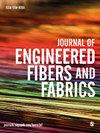采用先进的实验设计方法,对上浆机设置和浆纱拉伸性能进行了多响应优化
IF 2.3
4区 工程技术
Q1 MATERIALS SCIENCE, TEXTILES
引用次数: 0
摘要
在织布机上,经纱经历了异常高的机械应力和张力,以及明显的摩擦磨损。因此,严重的纱线断裂导致织机停工,从而导致生产和质量中断。为了缓解这个问题,经纱应该用一种合适的粘接剂涂上一层薄而结实的薄膜。因此,本研究的目的是研究浆纱机参数对纱线拉伸性能的影响,并优化浆纱的拉伸性能。采用Box-Behnken设计的设计专家11软件进行设计研究,分析实验结果,优化响应。在本研究中,三个因素,每个在三个水平(湿区纱线张力(A)(340, 380和420 N),挤压辊压力(B)(13, 15和17 N),上浆机速度(C)(30, 49和68 m/min),以及三个响应变量(增益强度,损失伸长率和拉伸)考虑。用给定因素的不同组合制作了15个浆纱样品,并测量了每个样品的响应变量值。观察到湿区纱线张力和挤压辊压力对纱线的增益强度、拉伸率和损失伸长率有显著影响。经回归分析,纱线的增益强度与湿区纱线张力成负相关,与挤压辊压力成正相关。在另一种情况下,湿区纱线张力和挤压辊压力都对纱线的损失伸长率和纱线拉伸率有显著的正向影响。在湿区纱线张力340 N、挤压辊压力13 N、上浆机速度51 m/min的条件下,获得了最佳的增强力(32.7 cN/tex)、损失伸长率(18.5%)和拉伸率(1.4%)。本研究采用的方法揭示了因素与反应之间的经验关系、因素对反应的交互效应以及多重反应优化。该优化结果可应用于经纱上浆,可显著提高纱线的拉伸性能和织机效率。本文章由计算机程序翻译,如有差异,请以英文原文为准。
Multiple response optimization of sizing machine settings and sized yarn tensile properties using advanced method of experimental design
On a loom, the warp yarns experience exceptionally high mechanical stresses and strains, as well as significant abrasion from friction. As a result, significant yarn breakages cause loom stoppages and, hence, production and quality interruptions. To mitigate this problem, the warp yarns should be treated with a thin, strong film of an appropriate adhesive. The aim of this study is therefore, to investigate the effect of sizing machine parameters on tensile properties of the yarn and to optimize the sized yarn tensile properties. Design expert 11 software with Box-Behnken design has been employed to design the research, analyze the results of experiments, and optimize the responses. In this research, three factors, each at three levels (wet zone yarn tension (A) (340, 380, and 420 N), squeezing roller pressure (B) (13, 15, and 17 N), and sizing machine speed (C) (30, 49, and 68 m/min), as well as three response variables (gain strength, loss elongation, and stretch), are considered. 15 samples of sized yarn have been produced with various combinations of the given factors, and the values of the response variables are measured for each sample. It has been observed that wet zone yarn tension and squeezing roller pressure have a significant effect on gain strength, stretch, and loss elongation. According to the regression analysis, gain strength has a negative relationship with wet zone yarn tension and a positive relationship with squeezing roller pressure. In the other case, both wet-zone yarn tension and squeezing roller pressure have a positive and significant effect on loss elongation and yarn stretch. At 340 N wet zone yarn tension, 13 N squeezing roller pressure, and 51 m/min sizing machine speed, the optimum values of gain strength (32.7 cN/tex), loss elongation (18.5%), and stretch (1.4%) were obtained. The methodologies employed in this study revealed the empirical relationship between the factors and the responses, the interaction effects of the factors on the responses, and multiple response optimizations. The optimized result of this study can be applied to the warp yarn sizing and can improve the tensile properties of the yarn and the loom’s efficiency significantly.
求助全文
通过发布文献求助,成功后即可免费获取论文全文。
去求助
来源期刊

Journal of Engineered Fibers and Fabrics
工程技术-材料科学:纺织
CiteScore
5.00
自引率
6.90%
发文量
41
审稿时长
4 months
期刊介绍:
Journal of Engineered Fibers and Fabrics is a peer-reviewed, open access journal which aims to facilitate the rapid and wide dissemination of research in the engineering of textiles, clothing and fiber based structures.
 求助内容:
求助内容: 应助结果提醒方式:
应助结果提醒方式:


